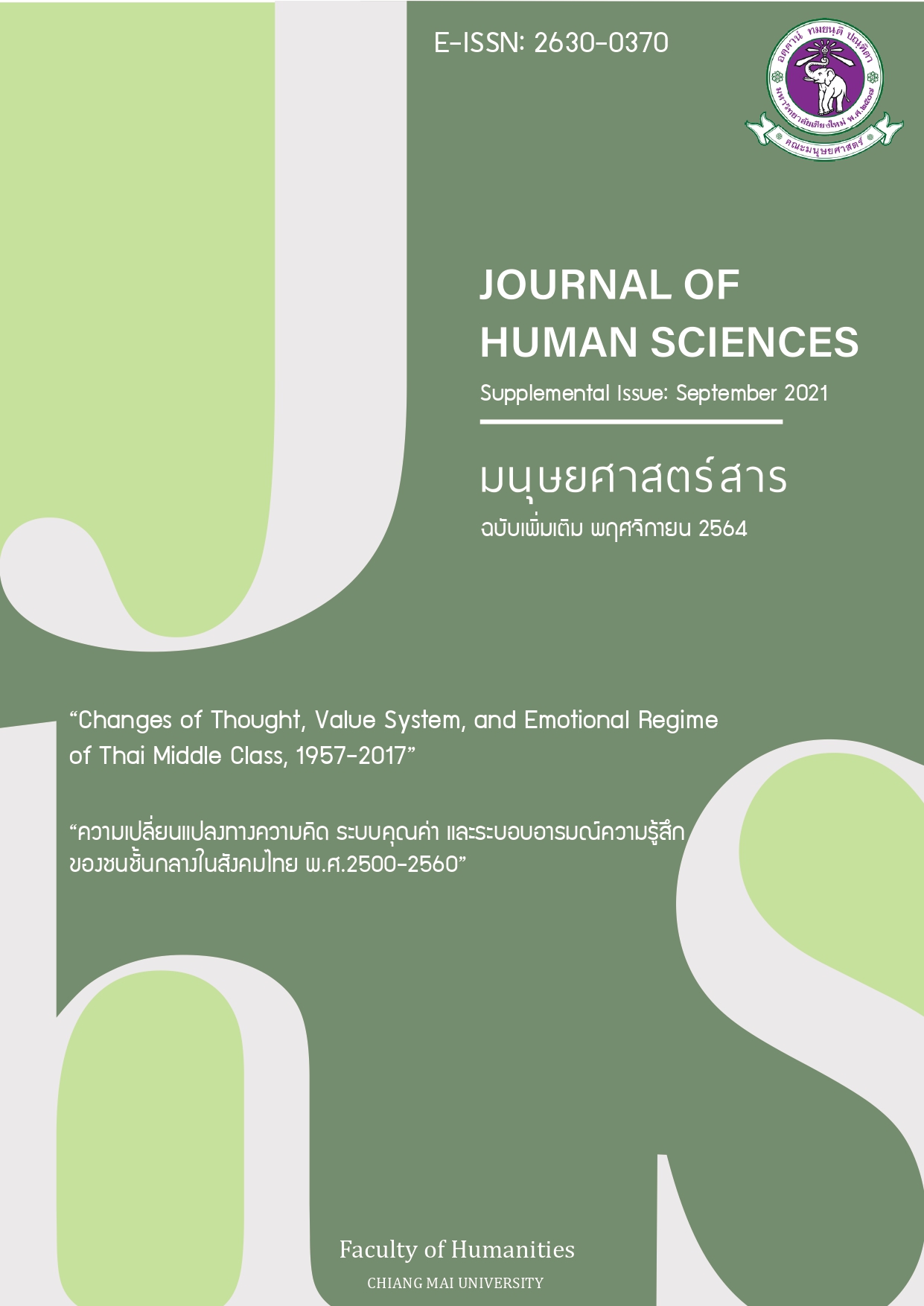จากความสัมพันธ์เชิงอุปถัมภ์สู่ความสัมพันธ์เชิงมิตรภาพ: อารมณ์ความรู้สึกและชีวิตครอบครัวของชนชั้นกลางไทยในทศวรรษ 2500-2530
Main Article Content
บทคัดย่อ
ความสัมพันธ์เชิงอุปถัมภ์เป็นความสัมพันธ์ของครอบครัวไทยแบบจารีต ผู้ชายในฐานะหัวหน้าครอบครัวจะต้องดำรงฐานะเป็นผู้ปกครอง ดูแล คุ้มครองและอุปถัมภ์สมาชิกจำนวนมากที่อยู่ภายในครอบครัว โดยสมาชิกภายในครอบครัวเหล่านี้ไม่จำเป็นต้องมีความผูกพันกันในทางสายเลือดเท่านั้น ทว่ายังรวมถึงญาติห่างๆ และข้ารับใช้ภายในครอบครัวอีกด้วย
บทความนี้ต้องการชี้ให้เห็นว่า ความเปลี่ยนแปลงทางเศรษฐกิจจากนโยบายการพัฒนาประเทศในช่วง ทศวรรษ 2500 เป็นต้นมา ส่งผลให้ความสัมพันธ์ภายในครอบครัวเปลี่ยนแปลงไป การเติบโตของภาคอุตสาหกรรมและภาคบริการทำให้ชายและหญิงจำนวนมากก้าวไปสู่การเป็นมนุษย์เงินเดือน พวกเขาเติบโตเป็นชนชั้นกลางรุ่นใหม่ที่ทำงานพึ่งตนเองได้ และตระหนักถึงคุณค่าในเชิงปัจเจกชนของตนเองมากขึ้น ชีวิตทางเศรษฐกิจแบบใหม่ยังเอื้อให้พวกเขานิยามความรักรูปแบบใหม่ที่คู่ชีวิตจะต้องยอมรับและเคารพในความเป็นตัวตนของกันและกันมากขึ้นด้วย พวกเขาสร้างครอบครัวแบบใหม่ที่แยกออกมาจากครอบครัวเดิม กล่าวในอีกทางหนึ่งคือ พวกเขาสร้างครอบครัวเดี่ยวที่มีสมาชิกจำนวนน้อย โดยมีความสัมพันธ์กันในเชิงมิตรภาพมากกว่าความสัมพันธ์เชิงอุปถัมภ์ดังในอดีตที่ผ่านมา
Article Details
เอกสารอ้างอิง
Bello, W., Cunningham, S., & Poh, L-K. (2000). Soknatkamsiam: KanphatthanalækantæksalaIkhong sangkhomthaisamaimai (phimkhrangthi Si) [Siamese Tragedy: the Development and Disintegration of Modern Thai Society (4th ed.)] Thongsila S. translator. Bangkok: Komolkeemthong Foundation.
Boonbongkarn, C. (1987). Nangsưanusornnainganphraratchathanphlœngsop Na Watthatthong Ha Kumphaphan Songphanharoisamsip [The Funeral Memorial book at That Thong Temple on 5 February, 1987]. N.P.
Boonyaket, T. (1973). Kan khrong rưan [Household]. Bangkok: Bannakit trading.
Chaiyachatchaovakul, T. (2000). Botbat khong bida nai thatsana but wairun [The Father’s Role in the View of the adolescent child]. (Master of Public Administration thesis, Thammasat University).
Chareonporn, S. (2003). Phapsanœphuyingnaiwannakamthaichuangthotsawat 2530: Wikhrokhwamyongyaikappradenthangsangkhom [The representation of women in Thai Literature of the B.E. 2530's: An Analysis of interconnections with social issues]. (Master of Social Development thesis, Chiangmai University.
Chusangsi, P. (1991). Khwamkhitkhongphuyingnainityasanphuying Pho.So. 2500-2516 [Woman’s thoughts in Women’s Magazines in 1957-1973]. (Master of History thesis, Thammasat University).
Delite. (1993). 3(31).
GM. (1986a). 1(2).
GM. (1986b). 1(3).
GM. (1986c). 1(4).
GM. (1987a). 2(13).
GM. (1987b). 2(18).
GM. (1995). 9(143).
Itsarasak, C. (1970). Lakkan khrong chiwit læ ngæ khit nai chiwit somrot (Phim khrang thi 6) [Principles of Life and Thoughts in Marriage (6th ed.)]. Bangkok; Rhae withaya.
Kajsongkram, K, Lieutenant General. (1967). Nangsưanusornnainganphraratchathanphlœngsop Na Watthepsirintharawat Yisip Mesayon Songphanharoisip [The Funeral Memorial book at Thep Sirin Thrawat Temple on 20 April, 1967].
Khamnampad, W. (2004). Dek kapkhwamkhatwangkhongratthaban Pho.So. Songphanharoisong Thưng Songphanharaʻayasipkao [Children and Government’s expectation in 1959-1976]. (Master of History thesis, Chiangmai University).
Khemmani, T., & Thirachitra, V. (ed.). (1992). Nunoinarak [An Adorable child]. Bangkok; Chulalongkorn University.
Leesirivit, C. (2008). Phap sanœ khong phuchai nai nittayasan plukčhai sưapa chuang pi Pho.So. 2517 - Pho.So. 2527 [Man’s image in pornographic magazine between 1974-1984]. (Master of Women Studies thesis, Thammasat University).
Mektrirat, N. (1992). Kan patiwat Sayam Pho.So. 2475 [1932 Siam’s Revolution]. Bangkok: The Foundation for the Promotion of Social Sciences and Humanities Textbooks Project.
Mongkonyuthanavee, Vice Admiral, Laung. (1976). Nangsưthiralưknainganphraratchathanphlœngsop Na Watmakutkasatriyaram Wanthi Siphok Minakhom Pi Songphanharaʻayasipkao [The Funeral Memorial book at Makutkasattriyaram Temple on 16 March, 1976]. N.P.
Nimmannorrawong, P. (2015). Prawatsatdeklæwaidekchuangtonrattanakosinthưngkanpatirupkanpokkhrong samairatchakanthi Ha [The History of Children and Childhood During the Early Bangkok Period to the Chakri Reformation]. (Master of History thesis, Thammasat University).
Nunoinarak [An Adorable child]. (1992). Khemmani, T., & Thirachitra, V. (ed.). Bangkok; Chulalongkorn University.
Perfetti, L. (2019). “In Private: The Individual and Domestic Community.” In Ruys, J. F. and Monagle, C. (Eds.), A Cultural History of the Emotions in the Medieval Age (pp. 119–32). London: Bloomsbury.
Phantprasit, P. (2013). Khwam plian plæng khong chi wit læ khwam rusưk nưkkhit khong phuying chonchanklang radaplangtangtæchuangthotsawat 2530 Thưngpatjubun [Transition of life and mentality of the lower middle class women from the late 1980s to the present]. (Master of History thesis, Chiangmai University).
Phongpaichit, P., & Baker, C. (1996). Thailand’s Boom. Chiang Mai: Silkworm Books.
Phuphaibul, R., Wittayasooporn, J., & Grisurapong, S. (1999). Phonkrathopkhongphawawikritsetthakittodek Yaowachon lækhropkhrua lækhwamtongkanchuailưa [The Effect of Economic Crisis in Children, Family and the Need of Help]. (Research, The Thailand Research Fund).
Praditsil, C. (1990). Setthasat kanmưang waduai kanwangphæn khropkhrua khong Thai: sưksa chak krabuankan nayobai [Political economics on family planning in Thailand: Study from the policy process]. (Master of Political Science thesis, Thammasat University).
Preaw Weekly. (1991). 8(190).
Putthapanasub, P. (1996). Kra buan kan nai kan kam not nayobai wang phæn khrop khrua khong prathed thai [Process of Setting the Family Planning Policy in Thailand]. (Master of Economics thesis, Chulalongkorn University).
Raklukhaithukthang [Love children in the Right Way]. (1988). Nakhonpathom: Institution for Population and Social Research Mahidon University.
Raklukhaithukthang Lem Song [Love children in the Right Way Volume 2]. (1990). Nakhonpathom: Institution for Population and Social Research Mahidon University.
Samutachak, B., et al. (2016). Khwamyudimisukkhongkhropkhruathai [Well-being of Thai Family]. (Research, The Thailand Research Fund).
Stearns, P. N. (2019). “In Private: The Individual and Domestic Community.” In Matt, S. J. (Ed.), A Cultural History of the Emotions in the Age of Romanticism, Revolution, and Empire (pp. 137–156). London: Bloomsbury.
Stearns, P. N. (2019). “In Private: The Individual and Domestic Community.” In Davidson, J. W. and Damousi, J. (Eds.), A Cultural History of the Emotions in the Modern and Post-Modern Age (pp. 111–128). London: Bloomsbury.
Suklapkit, S. (2013). Phua dieo mia dieo nai sangkhom Thai samai mai chak thotsawat 2410 thưng thotsawat 2480 [Monogamy in Modern Thai Society, 1870s-1940s]. (Master of History thesis, Chiangmai University).
Sukumolanandana, S. (1975). Sathængban [Home Economics]. Bangkok: Kledthai Press.
Sukumolanandana, S. (1989). Sattriphatthana [Women Empowerment]. Bangkok: Maekomphang Press.
Sukumolanandana, S., & Sivaraksa, S. (1988) Phliktamrahakhukhrong [How to searching for soulmates]. Bangkok: Foundation for Children.
Surathin, M. (1991). Nangsư thiralưk nưang nai ngan phraratchathan phlœng sop na wat trithot tho pheworawihan [the Funeral Memorial book at Tritodsathep temple]. N.P.
Thanomsasana, S. (2105). kan plianplæng thang khwamkhit khong chon chan klang Thai kap rưang ʻanlen Thai samai mai thotsawat songphansiroihoksip - thotsawat songphansiroipætsip [The Changing Perspective of the Thai Middle Class and Modern Thai Fiction, Late 1910s – Late 1940s]. (Ph. D. Dissertation (History), Chulalongkorn University).
Tedvisarn, W. (1987). Nangsưanusornnainganphraratchathanphlœngsoppenkranipiset Na Watthatthong Wanʻathitthi Nưng Kumphaphan Pho.So. Songphanharoisamsip [The Funeral Memorial book at That Thong Temple on 1 February, 1987]. N.P.
Tiptus, P., & Bongsadadt, M. (1982). Bannai: Rupbæplækanplianplængnairop Songroi Pi (Pho.So. Songphansamroiyisipha-Songphanharoiyisipha). [Houses in Bangkok: Patterns and Transition in 200 years (1782-1982)]. Bangkok: Chulalongkorn University Press.
Vichit-Vadakan, Luang. (1998). Wichakankhrongrưankhrongrak [The Science of Abiding Household]. Bangkok: Sangsanbooks.
Virayasiri, B. (1974). Nangsưanusornnainganchaponkitsop Na Watnawihan Wanthi Chet Makrakhom Songphanharoisipchet [The Funeral Memorial book at Somanasviharn temple on 7 January, 1974]. N.P.
Wacharanet, C. (1979). Sattri thi tham ngan kap phara khwamrapphitchop nai khropkhrua: sưksa chapho sattri thi tham ngan nai thanakhan phanit khet Krung Thep Maha Nakhon [Working Women and Family Responsibility: Study only for women working in Bangkok’s commercial banks]. (Master of Social Work thesis, Thammasat University).
Wongyannava, T., & friends. (2018). Khropkhruachintakam: Botwiphawaduaichumchon Kanpokkhrong lærat [Imagined family: the Criticism of Communities, Dominance and State]. Bangkok: Illuminations Editions.


